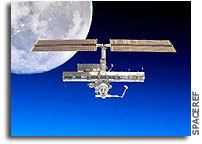NASA Space Station Status Report 1 October 2004

The International Space Station crew made steady progress with maintenance work this week, restoring an oxygen generator to partial operation and replacing a cabin air monitoring system.
Expedition 9 Commander Gennady Padalka and NASA ISS Science Officer Mike Fincke also began packing for the trip home. The Russian Federal Space Agency announced that launch of the next Station crew, Expedition 10 Commander Leroy Chiao and Flight Engineer Salizhan Sharipov, is scheduled for 10:06 p.m. CDT Oct. 13. NASA and Russian Station managers met today to review preparations for that mission in a Flight Readiness Review and found everything in order.
Aboard the ISS Soyuz 9 spacecraft with Chiao and Sharipov will be Russian Space Forces Test Cosmonaut Yuri Shargin. The trio will dock with the Station at 11:24 p.m. CDT Oct. 15. Padalka, Fincke and Shargin will return to Earth in the ISS Soyuz 8 spacecraft with a landing in Kazakhstan at 7:32 p.m. CDT Oct. 23. Chiao and Sharipov will remain aboard the Station for six months.
Padalka and Fincke continued troubleshooting the Elektron oxygen generator this week. It has operated intermittently during the past few weeks. The system creates breathing oxygen from water, venting hydrogen overboard from the Station in the process. With plans provided by Russian ground controllers, the crew hooked the system’s hydrogen venting line up to a different overboard valve in the Station’s Zvezda module. The valve is one that is normally used as part of an atmospheric contaminant control system.
Hooked up to the new vent valve, the Elektron has operated well during several day-long test runs. Meanwhile, the crew continued periodic cleaning of filters in the vent valve normally used by the Elektron, attempting to remove what are believed to be potassium hydroxide particles clogging the system.
Fincke replaced a U.S. air monitoring system in the Destiny Laboratory this week, restoring that system to full operation. Called the Major Constituents Analyzer, the equipment had previously only been operating periodically. Now, with the installation of a new Mass Spectrometer Unit that was delivered to the Station aboard the last Progress cargo craft, the system is operated continuously.
In other work this week, U.S. flight controllers completed a checkout of a Thermal Radiator Rotary Joint, a joint on the Station’s exterior that allows radiators to be swiveled to dissipate heat as efficiently as possible. The joints are not needed until more solar arrays are added to the Station after the Space Shuttle has resumed flights.
On Monday, beginning at 9:40 a.m. CDT, Padalka and Fincke will field questions from media representatives at NASA Headquarters, the Johnson Space Center and the Kennedy Space Center during an inflight news conference.
Science activities this week included several sessions by Fincke working with an investigation of soldering in space. Fincke soldered several samples of materials onboard the Station while ground investigators watched and provided real-time insights. The study is aimed at increasing the understanding of soldering capabilities in weightlessness, potentially to allow such equipment to be used for inflight electronics repairs on the Station and future spacecraft.
The crew also continued photographing observations of interesting geologic, environmental and other sites on Earth. The images are periodically transmitted to the ground and may be viewed online at:
http://spaceflight.nasa.gov/gallery/images/station/crew-9/ndxpage1.html
For information on the crew’s activities aboard the Space Station, future launch dates, as well as a list of opportunities to see the Station from anywhere on the Earth, visit:
Details on science operations provided by the Payload Operations Center at NASA’s Marshall Space Flight Center in Huntsville, Ala., visit:
The next ISS status report will be issued on Friday, Oct. 8 or earlier, if events warrant.








